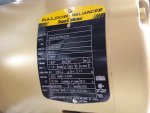wirebender
Senior Member
- Location
- North Central Texas
I have a 3HP 3phase 230/460V motor for a through the wall exhaust fan.
The wiring diagram shows 2 red wires labeled t-stat.
Under the diagram it says "Use a manual momentary start switch only".
I've not seen this before and am unsure what to do.
Does that mean it can't be line started?
The wiring diagram shows 2 red wires labeled t-stat.
Under the diagram it says "Use a manual momentary start switch only".
I've not seen this before and am unsure what to do.
Does that mean it can't be line started?



